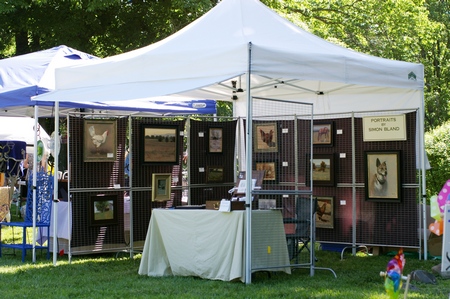Setting Up for an Event
Simon Bland: 14 Aug 2015
This post is a much edited version of an email that I sent to a friend who was thinking of selling work at an art fair.
If you're thinking of starting to sell your own artwork at events, I've tried to provide a list of the things you'll need. To start, here's my display set up (this is from an event I did in May 2014):

You can see that I've been lucky enough to set up on the end of a row. This is my preferred type of location because it lets more light in the tent and give customers room to view my paintings.
I try to set up for an event the day before it starts and then show up an hour early on the day finish getting ready. I used to take the paintings home with me overnight during a two day show, but when I started doing larger events I found that they usually have overnight security.
I have a checklist I go through while I pack to make sure I don't forget anything.
Tent
The tent is a typical 10' x 10' event tent (this one came from Costco). There are tons of choices available. You want one with a white canopy and you need to have fabric sides that can be put up overnight or in the event of rain.
It needs to be anchored to the ground so it won't blow away if the wind kicks up. They usually come with some pegs for the feet and guy ropes that attach to the top. Some people use weights to hold them down but it's a lot of extra weight to carry in the car if you're carrying all your other stuff too - however if you're standing on pavement they are a good idea.
Grid Walls
The grid walls are from http://www.graphicdisplaysystems.com/. I have ones just like they show on their front page with stands that stop them falling over. Three of those sections will fit on one side of your tent; I have seven of them. I made some backing from black fabric to stop light shining through - it makes the paintings easier to see if you're out in the sun.
The grid walls are fairly light and break down into two sections so they will fit in most station wagons. Mine are 12 years old and still as good as the day I got them.
Paintings can be hung from the grid walls using small drapery hooks.
Table
I use a small plastic collapsible table that might have come from WalMart and I use a washable polyester table cloth.
Chair
I got a great camp chair from Dicks Sporting goods. It lets me sit upright and has rails between the legs that stop it sinking into the ground. I can usually stand up for most of the time but by the end of a hot day I'm physically tired and need somewhere to sit.
Sign
I had a sign made at Sign Design in Purcellville, VA. It has some hooks on the back so I can mount it on the grid walls.
Things I have Out on the Table
I made a display box to hold my business cards and brochures. Other things on the table: a clipboard with a form to capture email addresses, a portfolio containing some examples of portraits, small unframed paintings.
Things You Can't See
A cooler with ice, water, ice tea, sandwiches and snacks. A spare pair of shoes: the grass is always wet when you show up in the morning and if you're not careful you can end up with wet feet all day. Extra clothes in case of a change in the weather. Boxes for the framed artwork.
A plastic bin containing:
- A first aid kit
- Bags
- A towel
- Cell phone with Square card reader and Square register app
- Price lists with the tax already calculated
- A multi-tool and a pair of scissors
- Cable ties (they are incredibly useful)
- Some string, tape, spare paper, kitchen roll
- Some small pieces of wood or shims to level the grid walls
- Hand cleanser
- Bug spray
Insurance
Lastly, I always make sure to take out show insurance from a provider like ACT. It mainly provides coverage against me causing damage to the show location or a patron injuring themselves in or around my booth.
Hope that helps!
Simon Bland: 14 Aug 2015